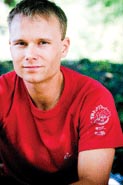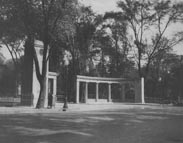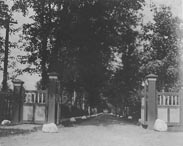In focus
Patrick Allaire: Top triathlete is scientist first

Claudio Calligaris
For most people, the thought of doing the Kona Ironman Triathlon in Hawaii is the stuff of nightmares. First, you have to swim 3.86 km through choppy seas. Follow that with a grueling 180.2 kilometer bike ride, often fighting gusts of wind that have been known to blow cyclists right off their saddles. Finally, you must will your weary legs to carry you through a 42.4 km run — a complete marathon — much of it traversing sun-baked lava fields.
Throw in a nasty bike crash early in the race, one in which you damage your hip and leave much of your skin on the scorching Hawaiian blacktop and you have an idea of the monumental task that faced Patrick Allaire last October. Lying there on the sizzling pavement dazed and contused in this, his first ever World Triathlon Championships, Allaire had a decision to make: haul his bruised and bleeding body another 200 km to the finish line or simply drop out, nurse his wounds and chalk the whole ordeal up to experience.
"If I had crashed like that in training, for sure I would have just limped home," he says in the cafeteria of the Montreal Neurological Institute while taking a break from his PhD studies in neuroscience. "But this was Hawaii, the world championships. No way."
Instead, he climbed back on his bike. Rather than dwell on his painful hip that throbbed when he pedaled, or the searing sting where sweat met open wound, Allaire focused on moving forward. When he finally crossed the finish line some 10 hours after the starter's pistol rang out, Allaire found himself in 18th position in the M25-29 age group and an impressive 119th in a field of over 1,700. Not bad for someone who undertook his first triathlon a mere four years before.
What makes Allaire's story even more compelling is that, unlike other top athletes, he has not put the rest of his life on hold in order to pursue his sporting dreams. "My first love is science," he admits, "and I don't think that will ever change."
Allaire was actually steered toward triathlon through science. Like so many young Quebecois, he grew up playing hockey. However, the demands of lab work at McGill meant that he began missing practices. "I'm just not the type of person who can do something halfway," he explains, "so I began looking for a sport that I could do alone and work around my schedule." Triathlon fit the bill.
Most weekdays, Allaire gets up at 5:15 to do his first workout before heading off to the lab. Next, he slips on his jogging gear and runs to the MNI where he works on experiments and check results. Time permitting, he slips out for a swim, run or bike ride during lunch. "Luckily, in my line of work, there's almost always something incubating," he says with a laugh. He also crams up to 16 hours of training in on the weekends.
Although he trains by himself, Allaire isn't alone in his endeavors. Topflight bikes and tickets to Hawaii can put a competitor deep in debt. Allaire is grateful for the help he has received from sponsors like Kamik, Siemens, Caisse Populaire Desjardins and Cycle Technique. "Without them, this would be pretty tough to do."
Allaire smiles when asked if he's ever had a scientific epiphany during a race and been caught in the middle of a lava field with no computer or pen and paper to jot it down. "Sometimes I think about work during training, but not so much during a race. You have to be fully concentrated on things like your pace, your heart rate, your technique and how much you eat and drink. It really teaches you how to focus."
In fact, Allaire believes that triathlon has been a huge boon to his work. He recalls how, when he first started his studies at McGill, his mind would sometimes jump to the end of an experiment while it was still in the early stages. "I never made any huge mistakes, just little ones sometimes, but it was a weakness of mine. Now, because of doing triathlons, I am able to stay focused for long periods of time."
In spite of his World Championship success, Allaire remains the pragmatic scientist when asked about his competitive goals. Yes, the Olympics would be a wonderful experience, but dedicating his entire life to training is a step he's not willing to take. "Triathlon is a great passion of mine," he says, "but science is my priority. I'd like to keep on like this and see how far I can go, maybe a Top 30 finish in Hawaii. One day, I might have to stop racing, or at least slow down, but I'll be doing science for the rest of my life."
Milestone birthday for university landmark

Roddick Gates, 1927
COURTESY OF McGill Archives
They have been the backdrop for silent vigils marking genocides and vociferous marches protesting perceived indignities from war to tuition hikes to pharmaceutical giants. They have served as the departure point for official fund-raising events and historic walks, as well as for countless informal rendez-vous between friends, classmates and lovers. As if by magic, they welcome all in their embrace and yet they also offer refuge, however symbolic, from the big city clamour that lies just beyond. "They," of course, are the Roddick Gates, perhaps McGill's most recognizable structure, and on May 28 this year, they turned 80.

The old gates, circa 1900
COURTESY OF McGill Archives
The gates were a 1925 gift to the university from Lady Amy Redpath Roddick, wife of medical pioneer, Sir Thomas Roddick. Sir Thomas, who served as Dean of the Faculty of Medicine from 1901-08, was the driving force behind the Canada Medical Act, whereby physicians were granted the right to practice throughout the country and not just in the province in which they attained their licence.
The gates and their classical Greek-style colonnaded arms were designed with a clock tower because Sir Thomas was a stickler for punctuality. The great irony, however, is that the four clock faces are rarely synchronized, a fact that, were he around today, Sir Thomas would probably rectify himself.

